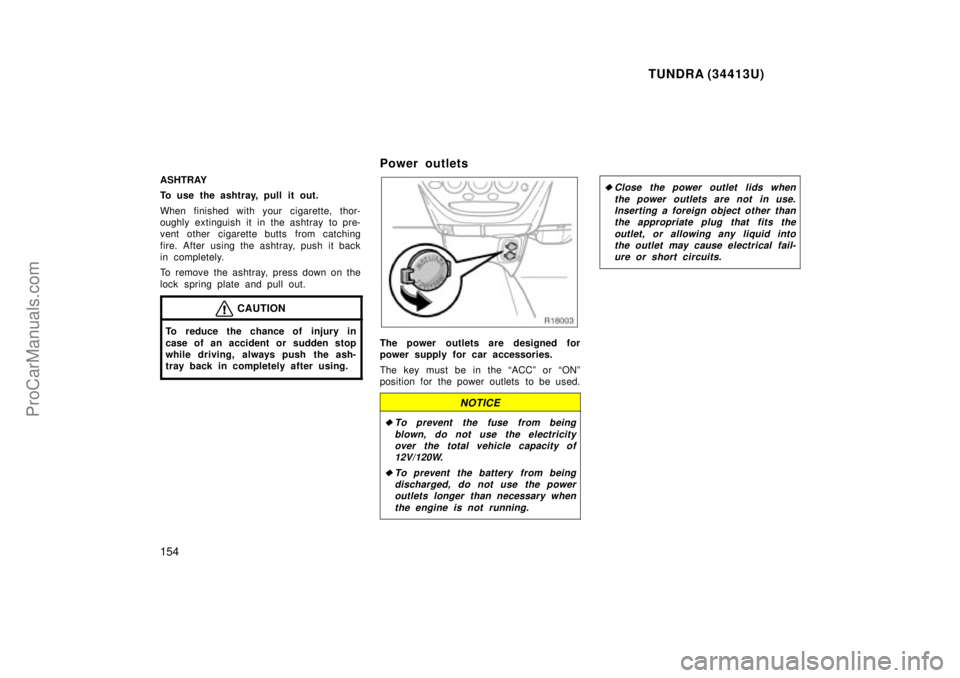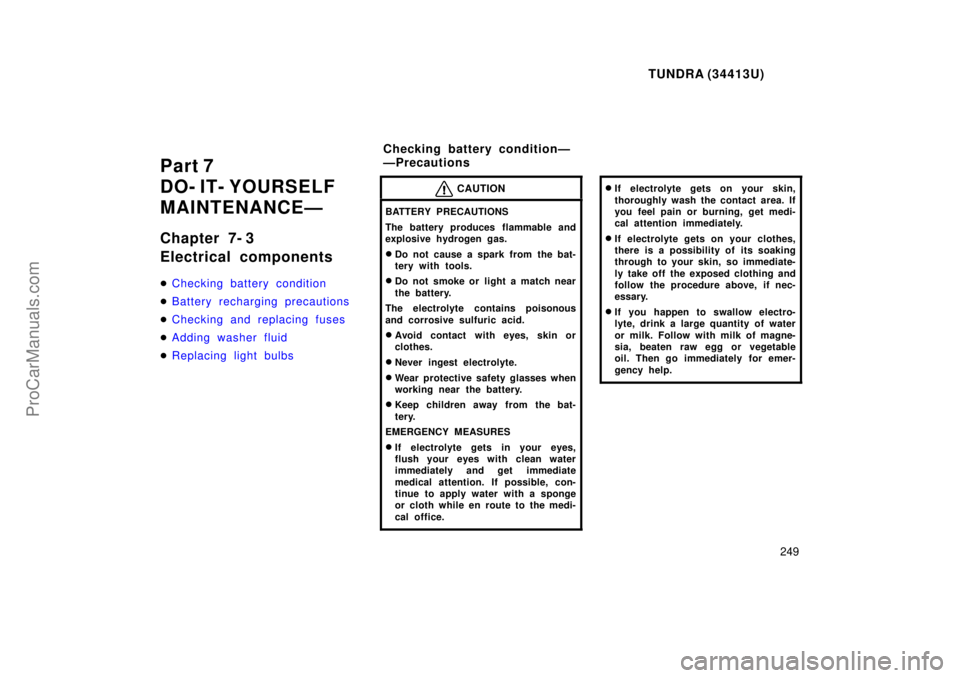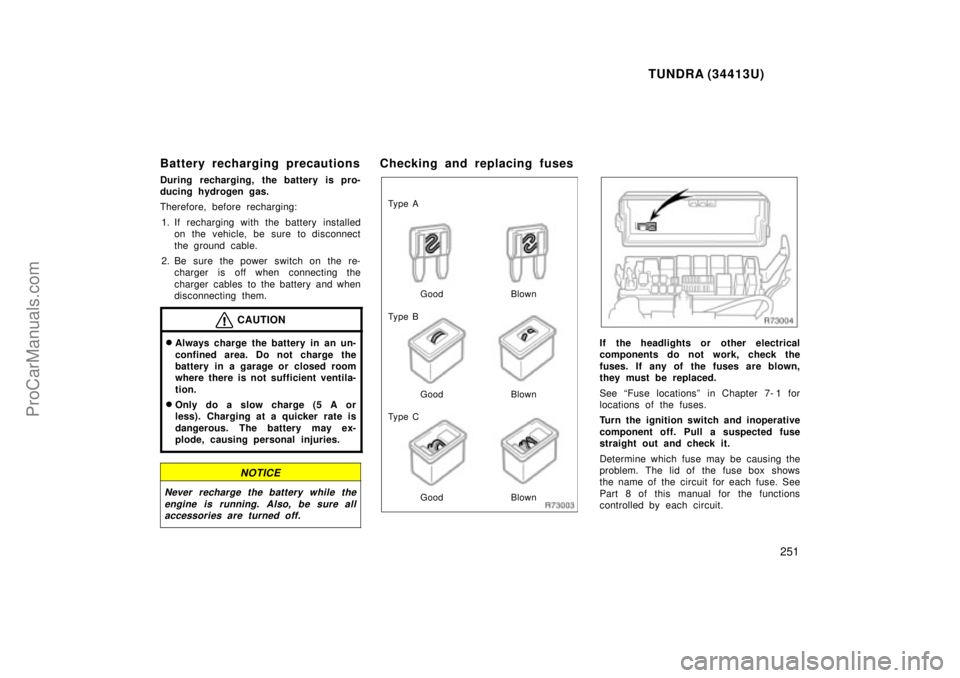Page 154 of 283

TUNDRA (34413U)
154
ASHTRAY
To use the ashtray, pull it out.
When finished with your cigarette, thor-
oughly extinguish it in the ashtray to pre-
vent other cigarette butts from catching
fire. After using the ashtray, push it back
in completely.
To remove the ashtray, press down on the
lock spring plate and pull out.
CAUTION
To reduce the chance of injury in
case of an accident or sudden stop
while driving, always push the ash-
tray back in completely after using.
Power outlets
The power outlets are designed for
power supply for car accessories.
The key must be in the ACCº or ONº
position for the power outlets to be used.
NOTICE
�To prevent the fuse from beingblown, do not use the electricityover the total vehicle capacity of12V/120W.
�To prevent the battery from beingdischarged, do not use the poweroutlets longer than necessary when
the engine is not running.
�Close the power outlet lids whenthe power outlets are not in use.Inserting a foreign object other thanthe appropriate plug that fits the
outlet, or allowing any liquid intothe outlet may cause electrical fail-ure or short circuits.
ProCarManuals.com
Page 231 of 283
TUNDRA (34413U)
231
Part 7
DO- IT- YOURSELF
MAINTENANCEÐ
Chapter 7- 1
Introduction
�Engine compartment overview
� Fuse locations
� Do- it- yourself service
precautions
� P ar t s and tools
ProCarManuals.com
Page 232 of 283
TUNDRA (34413U)
232
1. Engine oil filler cap
2. Brake fluid reservoir
3. Fuse blocks
4. Battery
5. Engine coolant reservoir
6. Engine oil level dipstick
7. Power steering fluid reservoir
8. Windshield washer fluid tank
Engine compartment overview
�5VZ- FE engine
ProCarManuals.com
Page 233 of 283
TUNDRA (34413U)
233
1. Power steering fluid reservoir
2. Engine oil filler cap
3. Brake fluid reservoir
4. Fuse blocks
5. Battery
6. Engine coolant reservoir
7. Engine oil level dipstick
8. Windshield washer fluid tank
�
2UZ- FE engine
ProCarManuals.com
Page 234 of 283
TUNDRA (34413U)
234
Fuse locations
Spare fuses
With towing kit
ProCarManuals.com
Page 237 of 283
TUNDRA (34413U)
237
Checking brake fluid
Parts (if level is low):
�SAE J1703 or FMVSS No.116 DOT 3
brake fluid
Tools:
�Rag or paper towel
�Funnel (only for adding fluid)
Checking power steering fluid
Parts (if level is low):
�Automatic transmission fluid DEXRON� II
or III
Tools:
�Rag or paper towel
�Funnel (only for adding fluid)
Checking battery condition
Tools:
�Warm water
�Baking soda
�Grease
�Conventional wrench (for terminal
clamp bolts) Checking and replacing fuses
Parts (if replacement is necessary):
�Fuse with same amperage rating as
original
Adding washer fluid
Parts:
�Water
�Washer fluid containing antifreeze
(for winter use)
Tools:
�Funnel
Replacing light bulbs
Parts:
�Bulb with same number and wattage
rating as original (See charts in Re-
placing light bulbsº in Chapter 7- 3.)
Tools:
�Screwdriver
�Wrench
ProCarManuals.com
Page 249 of 283

TUNDRA (34413U)
249
Part 7
DO- IT- YOURSELF
MAINTENANCEÐ
Chapter 7- 3
Electrical components
�Checking battery condition
� Battery recharging precautions
� Checking and replacing fuses
� Adding washer fluid
� Replacing light bulbs
CAUTION
BATTERY PRECAUTIONS
The battery produces flammable and
explosive hydrogen gas.
�Do not cause a spark from the bat-
tery with tools.
�Do not smoke or light a match near
the battery.
The electrolyte contains poisonous
and corrosive sulfuric acid.
�Avoid contact with eyes, skin or
clothes.
�Never ingest electrolyte.
�Wear protective safety glasses when
working near the battery.
�Keep children away from the bat-
tery.
EMERGENCY MEASURES
�If electrolyte gets in your eyes,
flush your eyes with clean water
immediately and get immediate
medical attention. If possible, con-
tinue to apply water with a sponge
or cloth while en route to the medi-
cal office.
�If electrolyte gets on your skin,
thoroughly wash the contact area. If
you feel pain or burning, get medi-
cal attention immediately.
�If electrolyte gets on your clothes,
there is a possibility of its soaking
through to your skin, so immediate-
ly take off the exposed clothing and
follow the procedure above, if nec-
essary.
�If you happen to swallow electro-
lyte, drink a large quantity of water
or milk. Follow with milk of magne-
sia, beaten raw egg or vegetable
oil. Then go immediately for emer-
gency help.
Checking battery c onditionÐ
ÐPrecautions
ProCarManuals.com
Page 251 of 283

TUNDRA (34413U)
251
Battery recharging precautions
During recharging, the battery is pro-
ducing hydrogen gas.
Therefore, before recharging:1. If recharging with the battery installed on the vehicle, be sure to disconnect
the ground cable.
2. Be sure the power switch on the re- charger is off when connecting the
charger cables to the battery and when
disconnecting them.
CAUTION
�Always charge the battery in an un-
confined area. Do not charge the
battery in a garage or closed room
where there is not sufficient ventila-
tion.
�Only do a slow charge (5 A or
less). Charging at a quicker rate is
dangerous. The battery may ex-
plode, causing personal injuries.
NOTICE
Never recharge the battery while the
engine is running. Also, be sure allaccessories are turned off.
Checking and replacing fuses
Ty p e A
Good Blown
Ty p e B
Ty p e C Good Blown
Good Blown
If the headlights or other electrical
components do not work, check the
fuses. If any of the fuses are blown,
they must be replaced.
See Fuse locationsº in Chapter 7- 1 for
locations of the fuses.
Turn the ignition switch and inoperative
component off. Pull a suspected fuse
straight out and check it.
Determine which fuse may be causing the
problem. The lid of the fuse box shows
the name of the circuit for each fuse. See
Part 8 of this manual for the functions
controlled by each circuit.
ProCarManuals.com